INTRODUCTION
Pig production in the developing countries has been adversely affected by a number of factors traceable to environmental, nutritional management and perhaps genetic factors. Controlling these factors will impact positively on the animal’s overall productivity. More importantly, biological free radicals have been strongly implicated as one of the major causes of poor performance and low productivity in a high intensive animal production (Nwangwu,2012). A supply of antioxidants in the diet of pigs can provide a natural boost towards free radical control and the balance between the antioxidants in the diet, gastro-intestinal tract, plasma and tissues is an important determinant of health status (Varley,2009). Research has shown the benefit of careful combination of different antioxidants and far more effective is a combination of different natural antioxidant options that can enhance the body defense mechanism and improve production through careful nutritional supplementation. This can provide significant support to the natural systems to improve animal health, welfare and ultimately performance. A combination of vitamins E and C can therefore provide a platform for this effect since studies have suggested that vitamins E and C act synergistically. The overall antioxidant potential has been shown by Gey (1998) to be more efficient and crucial than single antioxidant nutrient. In this respect, vitamins E and C work together such that vitamin E is the major chain-breaking antioxidant in lipid phase and the oxidizing free radical chain reactions are terminated by vitamin C in aqueous compartments of the animal body.
Objective of the Study
To assess the growth performance of weaner pigs fed combinations of different levels of vitamins E and C using the following parameters: body weight, growth rate, linear body measurements, feed intake and feed conversion ratio.
Materials and Methods
The study was carried out at the piggery unit of the Department of Animal Science farm, University of Nigeria, Nsukka. The study lasted for ninety-five days. A total of thirty-six(36) eight-week old Large White x Landrace cross-bred weaner pigs with an average weight of 9.7kg were used to investigate the effect of different levels of dietary supplementation of vitamins E and C on the growth performance of pigs. The pigs were housed in an open sided fly-proof pens measuring 3.2 x 2.7m with concrete feeding troughs and drinkers. The pigs were randomly assigned to nine treatments. There were two replicates per treatment with two pigs per replicate making a total of four (4) pigs per treatment. A week to the arrival of the animals, the pens were cleaned, washed and subsequently disinfected to reduce the risk of disease transmission. The animals on arrival were dewormed and placed on two weeks equilibration period in order to get acclimatized to the environment as well as feed and water. The pigs were ear-notched for easy identification and were fed 6% of their body weight as their daily ration. 3% of the ration was fed to the pigs at 0800hrs while the other 3% was fed at 1700hrs until the pigs attained five (5) months of age. Water was provided adlibitum. The initial weights of the pigs and their linear body measurements were recorded before the start of the experiment. Thereafter, weekly body weights and linear body measurements were taken and continued till the pigs reached five months of age. One experimental diet with 18% CP and 2800Kcal/kgME was formulated for the pigs in the nine treatments but had different levels of vitamins E and C assigned to each treatment. The vitamins were administered through the feed at the time of feeding and not stored with the feed to avoid loss of potency.
The percentage and proximate composition of the experimental diet are presented in tables 1 and 2, respectively.
Table 1: Percentage Composition of Experimental Diet .
Table 2: Proximate Composition of Experimental Diet (DM basis)
Result and Discussion
The results of the effects of dietary supplementation with vitamins E and C on final body weight, weight gain, feed intake, feed conversion ratio and linear body measurements of pigs are presented in tables 3,4,5,6 and 7, respectively.
Table 3: Effect of Dietary Vitamins E and C on Final Body weight of Gilts (kg)
Table 4: Effect of Dietary Vitamins E and C on Daily Weight Gain of Gilts (kg/gilt)
Table 5: Effect of Dietary Vitamins E and C on Daily Feed Intake of Gilts (kg/gilt)
Table 6: Effect of Dietary Vitamins E and C on Feed Conversion Ratio
Table 7: Effect of dietary supplementation with levels of vitamins E and C on linear body measurements of gilts
The result of this study showed significant interaction of dietary vitamins E and C on the body weight and growth rate of pigs. Pigs on a combination of 60 IU vitamin E/ 250 mg vitamin C performed significantly better than gilts on the other dietary treatments. This was followed by pigs on dietary vitamin E alone. The lowest body weight, average daily weight gain, daily feed intake and worst feed conversion efficiency values were recorded among the pigs on 60 IU vitamin E alone. This result therefore implies that 60 IU vitamin E alone was incapable of promoting the growth performance of pigs. However pigs on a combination of 60 IU vitamin E and 250 mg vitamin C and those of 120 IU vitamin E alone were better in their growth performance indices than pigs on the various levels of vitamin C alone and other levels of vitamins E and C combinations. The superiority of a combination of 60 IU vitamin E and 250 mg vitamin C and also 120 IU vitamin E alone over other dietary treatments was demonstrated in this study. These results are in consonance with the work of Hoechler and Marquardt (1996) who observed that vitamin C enhanced the biological efficacy of vitamin E. Thus the interaction between vitamins E and C positively affected the pig’s performance. The result is also in line with the report of Daza et al. (1999) who observed that vitamin E inclusion in the diets of pigs effectively improved weight gain, feed intake and feed conversion efficiency. Similarly, Cheah (1993) had reported significant improvement in the growth rate of Landrace x Large White weaner pigs that received daily vitamin E supplementation of 120 IU/kg of feed.
The mean growth rate value of 680±54.34g/day for pigs on a combination of 60 IU vitamin E and 250 mg vitamin C conforms with the report of Edward (2009) as an ideal growth rate value expected from an improved breed of pig with good nutrition and management practices. Greater growth rate according to Lebret et al. (2006) leads to a heavier live weight as a result of higher rate of deposition of muscle and fat tissues. Monahan et al. (1990) had reported improved growth rate of grower pigs with increased dietary vitamin E from 100 to 165 IU/kg of feed than the control group.
Nutrition most importantly, especially in this type of study plays a major role in the growth performance of animals and the quantity and quality of feed eaten within a specific period of time are key factors for growth performance of animals. In this case however, since feed intake did not vary significantly among the gilts, the variations in growth performance among the gilts in the various dietary treatments can possibly only be attributed to the individual differences in genetic potential for growth. Apart from significant interaction witnessed among the gilts on dietary combination of 60 IU vitamin E and 250 mg vitamin C, significant main effect was also obvious in pigs on 120 IU vitamin E alone.
The poor growth performance of pigs on dietary vitamin supplementation of 250 mg vitamin C alone and 60 IU vitamin E alone could be attributed to the inability of the level of the vitamins to maximize the growth potential of the pigs. This is in agreement with the report of Ugwu and Onyimonyi (2009), that dietary treatment which may decrease growth rate could delay growth and development in animals. Also, at 500 mg vitamin C supplementation alone, pigs were not able to express their full growth potential inspite of the high level of inclusion. The reason for this is not clear. However, it may not be unconnected with the observation of Varley (2009) who reported that high levels of vitamin C in the diet could become a pro-oxidant which in turn will generate free radicals in animal body thereby reducing performance.
The significant differences in linear body measurements existing among pigs in the various dietary vitamins E and C based diets on one hand and also between pigs on the control diet on the other hand could not possibly be completely attributed to effect of vitamin supplementation but also to genetic composition of the pigs. This because the linear body measurements of the pigs on the control diet, though similar to those of pigs on a combination of 60 IU vitamin E and 250 mg vitamin C and those of 120 IU vitamin E alone, seemed better than other vitamin supplemented pigs. This variation in linear body measurement of gilts is in consonance with the report of Afolayan et al. (1999) and Oke et al. (2006) who noted that since growth characteristics of pigs are inherited, there is the tendency for variation to occur in linear body measurements. The variations that occurred in linear body measurements of the animal in this study have arisen as a result of individual genetic differences among the pigs. Pigs on a combination of 60 IU vitamin E and 250 mg vitamin C had wider heart girth than pigs on other dietary treatments, followed by pigs on 120 IU vitamin E alone.
Conclusion
Based on the results of this study, an improved growth performance of pigs in terms of body weight, daily weight gain and linear body measurements were all observed in pigs on a dietary supplementation of a combination of 60 IU vitamin E and 250 mg vitamin C. Also at a level of 120 IU vitamin E supplementation, growth performance of pigs was effectively improved. The results of this study therefore suggest that dietary supplementation of growing pigs with a combination of 60 IU vitamin E and 250 mg vitamin C was better and superior to other levels of supplementation used in this study in promoting growth in pigs. It also suggests that at 120 IU vitamin E supplementation, pigs can still perform maximally in terms of growth. This work therefore upholds that vitamins E and C work synergistically and that the combined effects of the two antioxidants are additive and immunomodulatory. It is then recommended that the growth diets for pigs be supplemented with at least a mixture of 60 IU vitamin E and 250 mg vitamin C or just 120 IU vitamin E to enhance growth performance.
References
Afolayan, R.A., A.E Malay-Admi., A.A. Osinowo and O.O. Oni (1999) Genetic analysis of the growth performance of cross-bred sheep. Proc. Ann. Conf. nig. Soc. For Anim. Prod. Pp 300-301.
Cheah, K. S. (1993) Effect of dietary supplementation of vitamin E on pig growth and meat quality. Meat sci. 39: 255
Daza, A., E.J.N. Bezerra and M. Gutierrezbarquin (1999) Milk production in cross bred sows (Large White x Landrace). Evolution and analysis of variation factors. Zootech 48: 67-74.
Edward, T. (2009) Article in pig nutrition presented at Australian Conference, 12-15 July, 2009.
Gey, K.F. (1998) Vitamins E and C and interacting co-nutrients required for optimum health. Biofactors, 7: 113-174.
Hoechler, D and R.R. Marquardt (1996) Influence of vitamins e and c on the toxic effects of ocharotoxin A and T-2 toxin in chicks. Poult. Sci.74: 1508-1515.
Lebret, B., Meunier-Salaun, M.C., Foury, A., Mormede, P., Drausfield, E and Dourmad , J.Y. (2006) Influence of rearing conditions on performance, behavioural and physiological responses of pig to pre-slaughter handling, carcass trait and meat quality. J. Anim. Sci. 84(9): 2436-2447.
Monahan, F.J., D.J. Buckley., P.A. Monssey., P.B. Lynch and J.I Grey (1990) Effect of dietary alpha-tocopherol supplementation in porcine tissues and on susceptibility to lipid peroxidation. Food Sci. Nutr.42: 203- 212.
Nwangwu, A.C. (2012) Effect of dietary supplementation with vitamins E and C on the productive performance of pigs. Ph.D Thesis, University of Nigeria, Nsukka, 2012.
Oke, U.K., S.N. Ibe., F.I. Ologbose and K.U. Amaefula (2006) Effect of breed of sire on growth performance of exotic and cross-bred pigs in a humid tropical environment. J.Vet. Adv. 5: 744-748.
Ugwu, S.O.C and Onyimonyi, A.E. (2009) The growth performance of growing pigs during feed restriction and re-alimentation in humid tropical environment. Afr. J. Biotech. Vol.8(2) 343-347.
Varley, M. (2009) Article archive, composing a winning antioxidant team, SCA Nutec, Dalton. North Yorkshire, U.K.
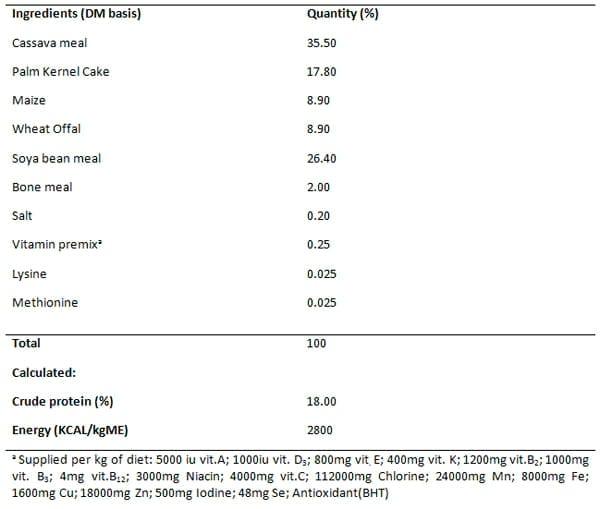
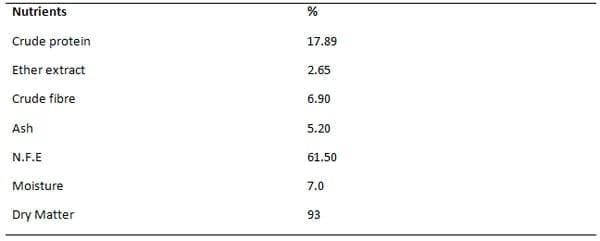
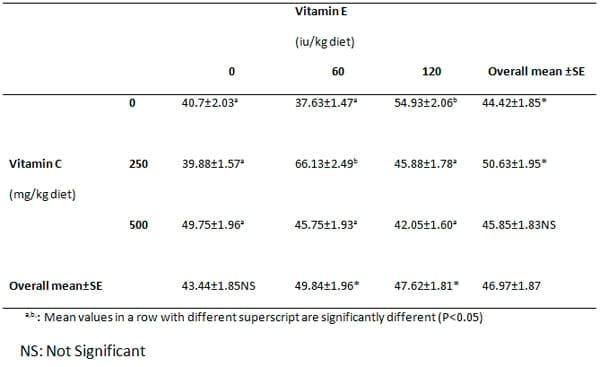

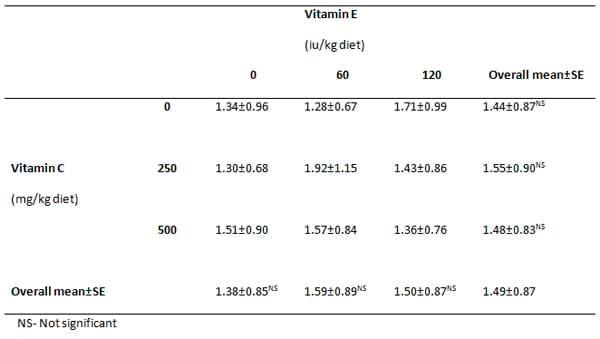
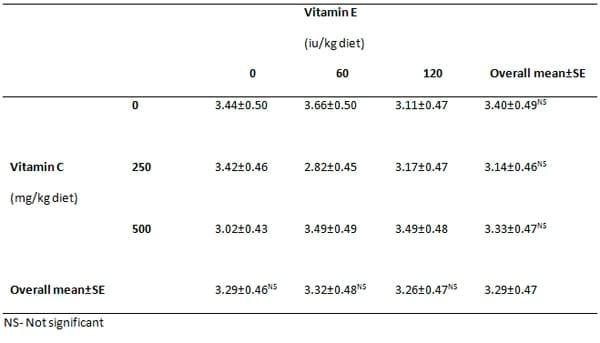







.jpg&w=3840&q=75)